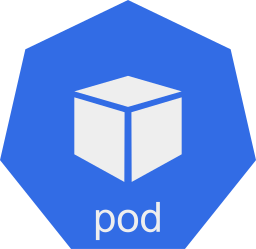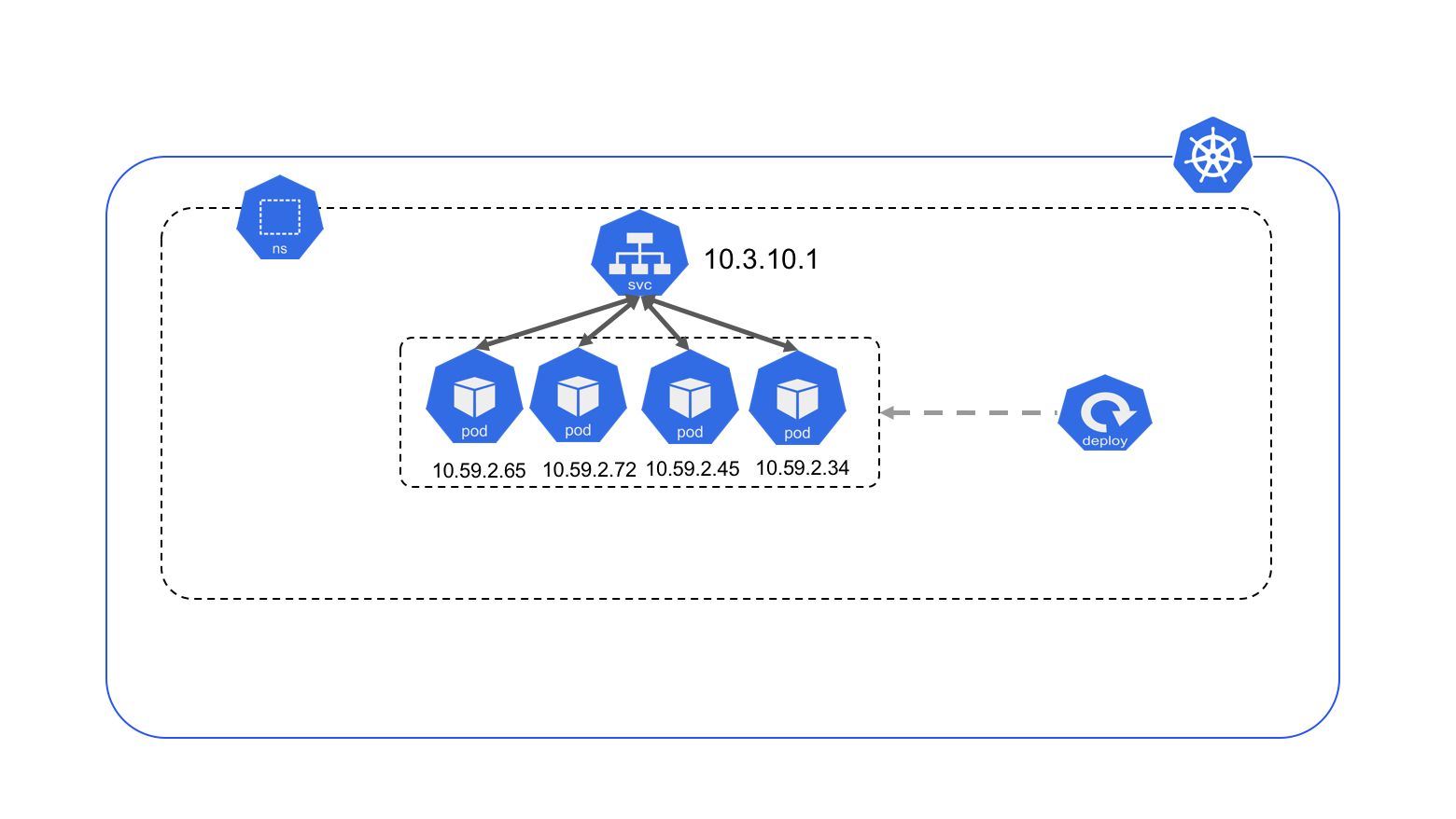Introduction to Kubernetes
Introduction to Kubernetes is a presentation giving attendees a thorough understanding of the fundamentals of Kubernetes.
whoami
James Strong

Technical Principal @ Contino
Certified Kubernetes Admin
Contino
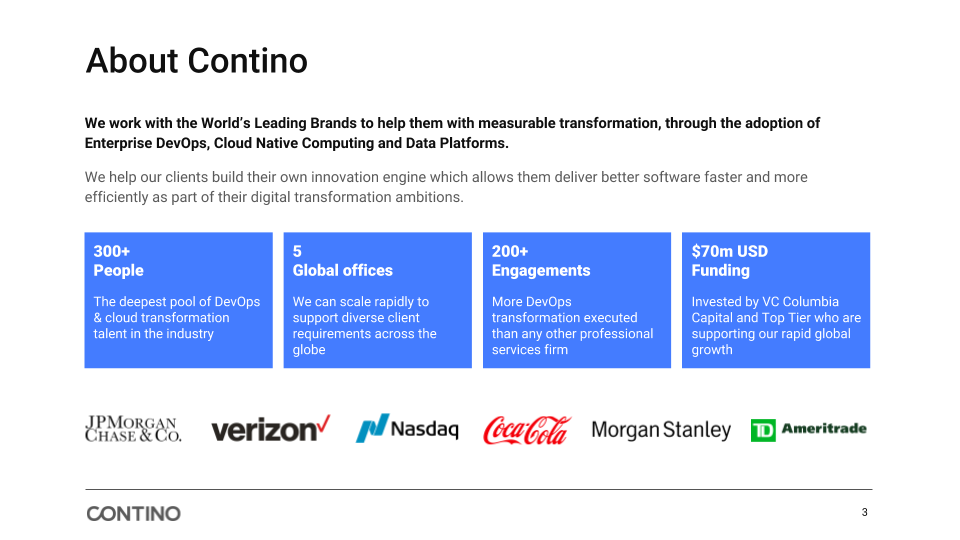
Agenda
Introduction
Containers
Kubernetes
Kubernetes Objects
Extras
History
In the beginning

The Hypervisor

2007
Container Primitives
- Control Groups
- Namespaces
Control Groups
Abbreviated cgroups, is a Linux kernel feature that limits, accounts for, and isolates the resource usage
- CPU
- memory
- disk I/O
- network
Namespaces
A feature of the Linux kernel that isolate and virtualize system resources of a collection of processes. Examples of resources that can be virtualized include:
- process IDs
- hostnames
- user IDs
- network access
- interprocess communication
- filesystems
Containers

Rise of the Containers (runtimes)
- lxc
- Docker ( containerd )
- rkt
- runc
- lmctfy
- cri-o

The orchestrator
2010
Mesosphere
2013
Docker Released
.1 release of Docker Compose
2014
Kubernetes released
Rancher Release 1.0 supports Docker Swarm, Meso and Kubernetes Docker container runtime
2016
Mesophere supports Docker, rkt, and appc for container runtimes
2017
Mesophere add supports for Kubernetes
2018
Docker EE 2.0 has support for the Kubernetes orchestrator
Containers Benefits
- Separation of concerns
- Developers focus on building their apps
- System admins focus on deployment
- Fast development cycle
- Application portability
- Build in one environment, ship to another
- Scalability
- Easily spin up new containers if needed
Dockerfile
- Instructions specify what to do when building the image
- FROM instruction specifies what the base image should be
- RUN instruction specifies a command to execute
- Comments start with “#”
- Remember, each line in a Dockerfile creates a new layer if it changes the state of the image
- You need to find the right balance between having lots of layers created for the image and readability of the Dockerfile
Dockerfile
- Don’t install unnecessary packages
- One ENTRYPOINT per Dockerfile
- Combine similar commands into one by using “&&” and “\”
- Use the caching system to your advantage
- The order of statements is important
- Add files that are least likely to change first and the ones most likely to change last
Kubernetes
Kubernetes History
Kubernetes is an open-source system for automating deployment, scaling, and management of containerized applications.
Kubernetes History
- Kubernetes is heavily influenced by Google’s Borg system
- Released in 2014 when Google partnered with Linux foundation to form CNCF
- Often called K8s which is a Numeronym
- K[ubernete]s → K[8]s → K8s
- Kubernetes - Greek for helmsman or pilot
- Kubernetes v1.0 was released on July 21, 2015
Kubernetes History
“Kubernetes was built to radically change the way that applications are built and deployed in the cloud. Fundamentally, it was designed to give developers more velocity, efficiency, and agility”
Kelsey Hightower, Brendan Burns & Joe Beda -Kubernetes Up and Running Book
CNCF Landscape
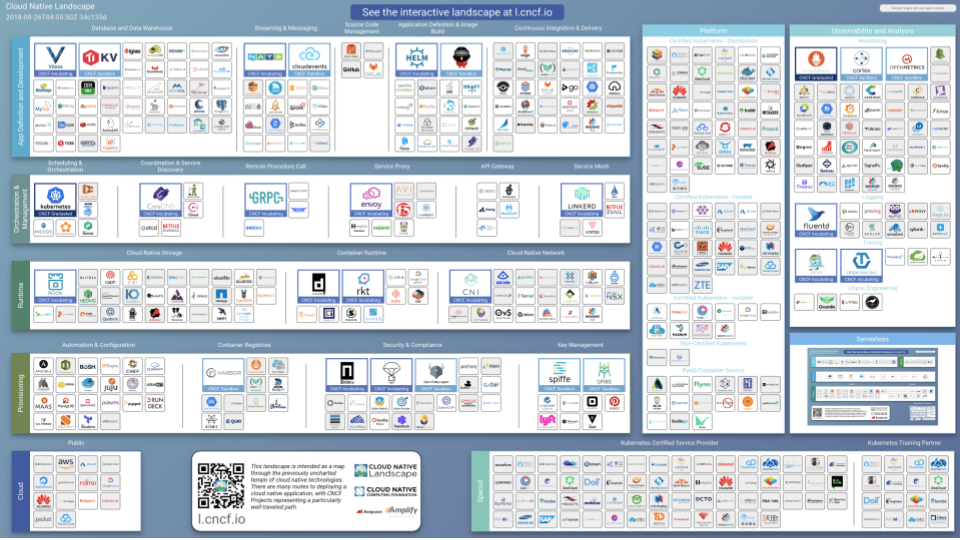
CNCF Landscape
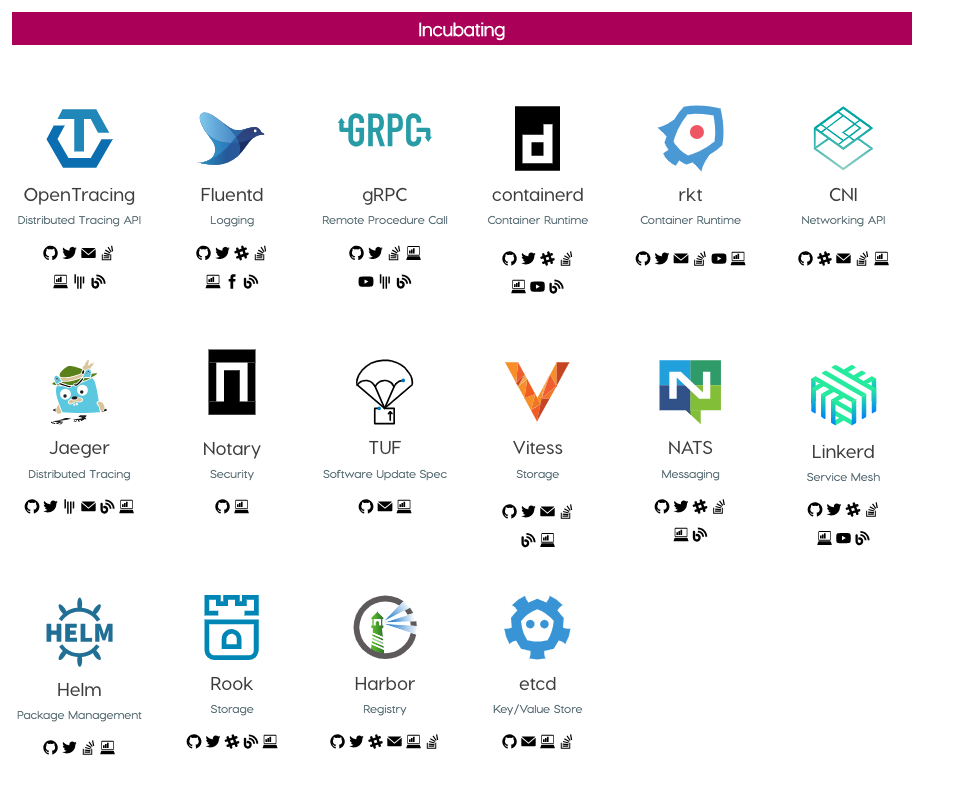
CNCF Landscape

CNCF Involvement
Slack
High level Architecture
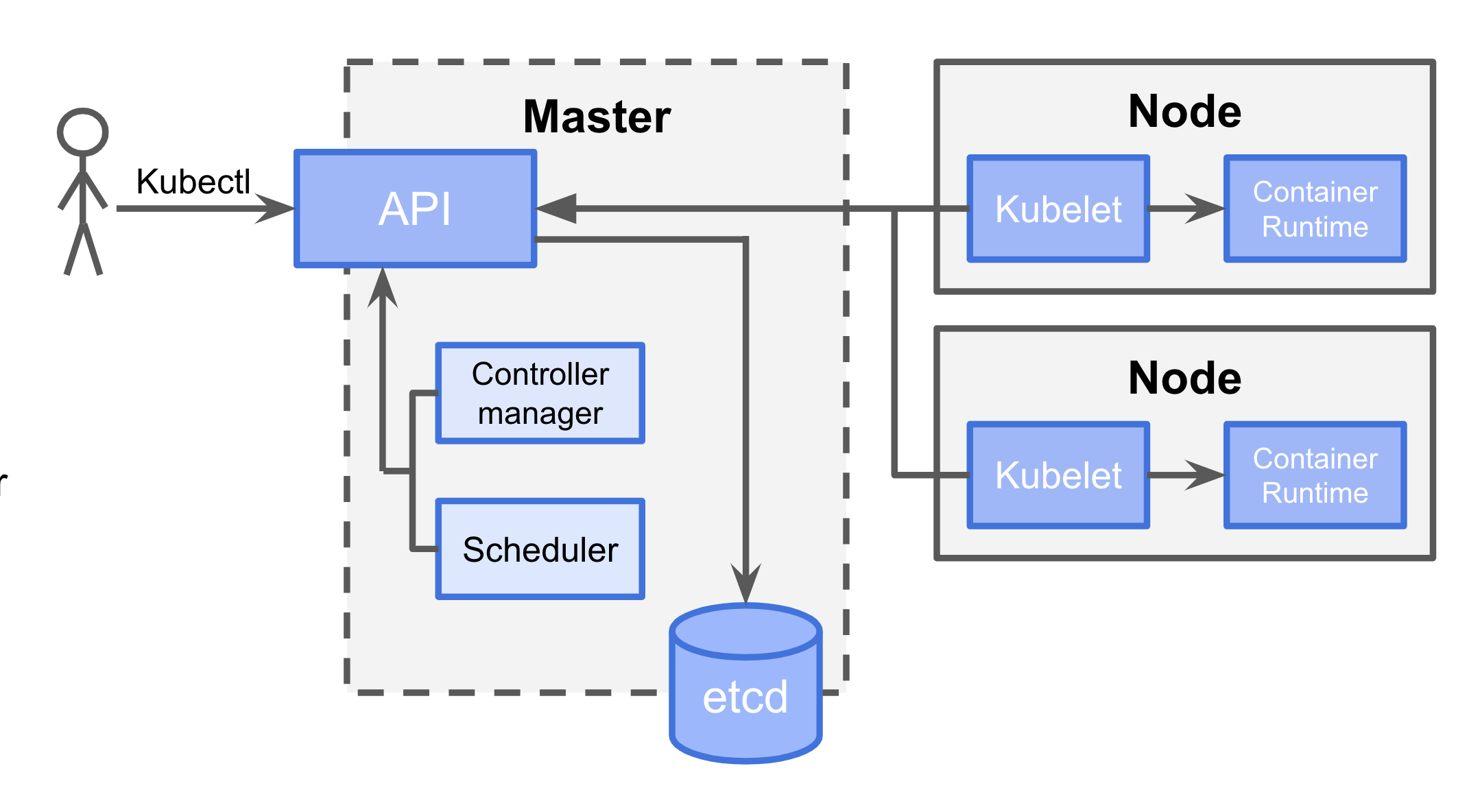
Master Node
Master Node
API data store: Etcd (Cluster State)
Controller Managers :
- Node Controller
- Deployment Controller
- ReplicaSet Controller
- Replication Controller
- Endpoints Controller
- Service Account & Token Controller
Scheduler: Bind pod to Node

Worker Node
Worker Node
Kubelet:
- cAdvisor (metrics, logs…)
Container Runtime:
- docker
Pod:
- Container (one or more)
Kube-proxy:
- Used to reach services and allow communication between Nodes.

Data Flow
CNI: Network Plugin in Kubelet that allows to talk to networking to get IPs for Pods and Services.
gRPC: API to communicate API Server to ETCD, Controller Manager and Scheduler
Kubelet - all K8s nodes have a kubelet that ensures that any pod assigned to it are running and configured in the desired state.
CRI(Container Runtime Interface) gRPC API compiled in kubelet which allows to kubelet to talk to container runtimes by using gRPC API.
The Container Runtime provider has to adapt it to CRI API to allow kubelet to talk to them by using OCI Standard (runc) Initially, Kubernetes was built on top of Docker as the container runtime. Soon after, CoreOS announced the rkt container runtime and wanted Kubernetes to support it, as well. So, Kubernetes ended up supporting Docker and rkt, although this model wasn’t very scalable in terms of adding new features or support for new container runtimes.
CRI consists of a protocol buffers and gRPC API, and libraries,
Data Flow

Kubernetes API Objects
Namespaces
Namespaces
Namespaces are virtual clusters inside your Kubernetes cluster that provide logically isolation (kinda) from each other.
Scope of names
Organization of Kubernetes resources
Pods
Pods
Pods are a collection of containers that share a namespace, are colocated and scheduled together on Kubenetes nodes.
A pod is a group of one or more containers, with shared storage/network, and a specification for how to run the containers
Pods

Labels
Labels are key/value pairs that are attached to objects, such as pods that help to identify that object.
Selectors
Label Selectors help client/user identify a set of objects.
spec:
selector:
matchLabels:
app: mysql
strategy:
type: Recreate
template:
metadata:
labels:
app: mysql
Demo
Create labels & use selector to identify set of objects
Resource Quotas
Resource Quotas
Requests - How much does this pod need to run
Limits - This pod only gets this much to run
Kubernetes being a multi-tenant environment, some applications may hog resources and starve others, Resource Quotas discourage this behavior
Resources
- CPU
- Memory
- Storage
- requests.storage
- persistentvolumeclaims
- storage-class-name.storageclass.storage.k8s.io/requests.storage
- storage-class-name.storageclass.storage.k8s.io/persistentvolumeclaims
Resources
- Object Count
- configmaps
- persistentvolumeclaims
- pods
- replicationcontrollers
- resourcequotas
- services
- services.loadbalancers
- services.nodeports
- secrets
- Priority - low, medium, high
Controllers
In Kubernetes, a controller is a control loop that watches the shared state of the cluster through the apiserver and makes changes attempting to move the current state towards the desired state. There are several in the Kubernetes Architecture that support different functions in the system.
Namespace controller - Creates and updates the Namespaces in kubernetes
Serviceaccounts controller - Manages the service accounts in the system, which are for processes to interact with Kubernetes.
Node Controller - Responsible for noticing and responding when nodes go down. Service Account & Token Controllers: Create default accounts and API access tokens for new namespaces.
Deployment Controller - A Deployment controller provides declarative updates for Pods and ReplicaSets.
Replication Controller - Responsible for maintaining the correct number of pods for every replication controller object in the system.
Endpoints Controller - Populates the Endpoints object (that is, joins Services & Pods). When services are created, the Endpoint controller manages the connection between services and the pods back the service.
Deployments
- Scaling
- Rolling
ReplicaSet
- Desired state
Strategies
- Recreate
- RollingUpdate (default)
- Blue/Green
- Canary
- A/B Testing
Storage
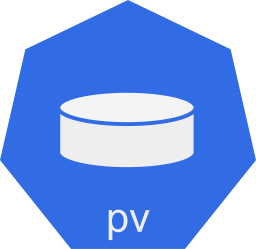
Storage
Storage like compute is another resource that must be managed. Kubernetes offers 3 types of storage
- Volumes
- Persistent Volumes
- Persistent Volume Claims
The Ephemeral nature of pods and containers lead to the need for data to be have a decoupled lifecycle outside of containers and pods.
Storage Classes
Storage classes allow cluster administrators to provide varing levels of support and types of storage to applications in a cluster
Example: Storage class that will provision an AWS EBS Volumes when referenced a PVC
kind: StorageClass
apiVersion: storage.k8s.io/v1
metadata:
name: standard
provisioner: kubernetes.io/aws-ebs
parameters:
type: gp2
reclaimPolicy: Retain
mountOptions:
- debug
volumeBindingMode: Immediate
Volume Types
Several volume types are supported
- awsElasticBlockStore
- azureDisk
- gcePersistentDisk
- hostPath
- secret
- configmaps
Volume Types Example
awsElasticBlockStore example yaml:
apiVersion: v1
kind: Pod
metadata:
name: test-ebs
spec:
containers:
- image: k8s.gcr.io/test-webserver
name: test-container
volumeMounts:
- mountPath: /test-ebs
name: test-volume
volumes:
- name: test-volume
# This AWS EBS volume must already exist.
awsElasticBlockStore:
volumeID: <volume-id>
fsType: ext4
Persistent Volumes
Persistent Volumes (PV’s) are a piece of storage provisioned in a cluster and can be used/reference in the cluster like another other resource.
Provisioning - Static or Dynamic
Types of PV’s
- GCEPersistentDisk
- AWSElasticBlockStore
- AzureFile
- CephFS
Example
kind: PersistentVolume
apiVersion: v1
metadata:
name: task-pv-volume
labels:
type: local
spec:
storageClassName: manual
capacity:
storage: 10Gi
accessModes:
- ReadWriteOnce
hostPath:
path: "/mnt/data"
Persistent Volume Claims
Persistent Volume Claims (PVC’s) - Allow pods to requests and attache Persistent Volumes available in the cluster.
When used in with Dynamic provision and Storage Classes, PVC’s can automatically make storage available on demand.
Types of PVC’s
- GCEPersistentDisk
- AWSElasticBlockStore
- AzureFile
- CephFS
Example
kind: Pod
apiVersion: v1
metadata:
name: mypod
spec:
containers:
- name: myfrontend
image: nginx
volumeMounts:
- mountPath: "/var/www/html"
name: mypd
volumes:
- name: mypd
persistentVolumeClaim:
claimName: myclaim
Storage Demo
Create a persistent volume and claim
kubectl apply -f mysql-pv.yaml
Create a pod that will use it.
kubectl apply -f mysql-pod.yaml
Clean up
kubectl delete -f mysql-pv.yaml
kubectl delete -f mysql-pod.yaml
Secrets
Secrets
Kubernetes object to inject sensitive data into containers
Sensitive data should never be built into the container image, in order to do that, kubernetes offers Secrets.
Secrets
echo -n 'admin' | base64
YWRtaW4=
echo -n '1f2d1e2e67df' | base64
MWYyZDFlMmU2N2Rm
Write a Secret that looks like this:
apiVersion: v1
kind: Secret
metadata:
name: mysecret
type: Opaque
data:
username: YWRtaW4=
password: MWYyZDFlMmU2N2Rm
Secrets ENV
apiVersion: v1
kind: Pod
metadata:
name: secret-env-pod
spec:
containers:
- name: mycontainer
image: redis
env:
- name: SECRET_USERNAME
valueFrom:
secretKeyRef:
name: mysecret
key: username
- name: SECRET_PASSWORD
valueFrom:
secretKeyRef:
name: mysecret
key: password
restartPolicy: Never
Secrets File
apiVersion: v1
kind: Pod
metadata:
name: mypod
spec:
containers:
- name: mypod
image: redis
volumeMounts:
- name: foo
mountPath: "/etc/foo"
readOnly: true
volumes:
- name: foo
secret:
secretName: mysecret
Configmaps
Configmaps
In order to keep the immutablity of a docker image, the configuration must live outside the container image, K8 config maps enable this.
Secrets, env variables, and other environment specific items should not be baked into a container image.
Configmaps
Yaml
apiVersion: v1
data:
game.properties: |
enemies=aliens
lives=3
enemies.cheat=true
enemies.cheat.level=noGoodRotten
secret.code.passphrase=UUDDLRLRBABAS
secret.code.allowed=true
secret.code.lives=30
ui.properties: |
color.good=purple
color.bad=yellow
allow.textmode=true
how.nice.to.look=fairlyNice
kind: ConfigMap
metadata:
name: game-config
namespace: default
Configmaps
Environment Vars
apiVersion: v1
kind: Pod
metadata:
name: dapi-test-pod
spec:
containers:
- name: test-container
image: k8s.gcr.io/busybox
command: [ "/bin/sh", "-c", "echo $(SPECIAL_LEVEL_KEY) $(SPECIAL_TYPE_KEY)" ]
env:
- name: SPECIAL_LEVEL_KEY
valueFrom:
configMapKeyRef:
name: special-config
key: SPECIAL_LEVEL
- name: SPECIAL_TYPE_KEY
valueFrom:
configMapKeyRef:
name: special-config
key: SPECIAL_TYPE
restartPolicy: Never
Configmaps
Files from Volume mounts
apiVersion: v1
kind: Pod
metadata:
name: dapi-test-pod
spec:
containers:
- name: test-container
image: k8s.gcr.io/busybox
command: [ "/bin/sh", "-c", "ls /etc/config/" ]
volumeMounts:
- name: config-volume
mountPath: /etc/config
volumes:
- name: config-volume
configMap:
name: special-config
restartPolicy: Never
Ingress
Ingress
Ingress is a K8 object that allows external access to resources inside the cluster
Services, Pods and other objects are only accessible inside the cluster
Ingress Controllers
- In order for the ingress resource to work, the cluster must have an ingress controller running.
- This is unlike other types of controllers, which run as part of the kube-controller-manager binary, and are typically started automatically with a cluster.
- Choose the ingress controller implementation that best fits your cluster.
Ingress Controller
apiVersion: extensions/v1beta1
kind: Ingress
metadata:
name: test-ingress
spec:
backend:
serviceName: testsvc
servicePort: 80
Ingress controllers
Kubernetes supported Ingress Controllers:
Others that can be deployed:
Full list is here
Ingress Rules
Each http rule contains the following information:
- Host
- list of paths
- Backend service
Ingress Rule
apiVersion: extensions/v1beta1
kind: Ingress
metadata:
name: simple-fanout-example
annotations:
nginx.ingress.kubernetes.io/rewrite-target: /
spec:
rules:
- host: foo.bar.com
http:
paths:
- path: /foo
backend:
serviceName: service1
servicePort: 4200
- path: /bar
backend:
serviceName: service2
servicePort: 8080
Services
Service
Service: a named abstraction of software service, consisting of a port that the proxy listens on, and the selector that determines which pods will answer requests.
Pods come and go, and with that their IP address change rapidly. Services decouple the IP address from the application and serve as the IP address inside the cluster for an application running multiple pods.
More info here
Service
Application Deployment
Create a secret for the password between Wordpress and MYSQL
kubectl create secret generic mysql-pass --from-literal=password=YOUR_PASSWORD
Verify it is there
kubectl get secrets
Application Deployment
Deploy the service for mysql
kubectl apply -f mysql-service.yaml
Verify the service has endpoints.
kubectl get services -o wide
Application Deployment
Pod Deployment with health checks, PersistentVolume and claim
Since we have created the mysql pod several times, here is a yaml file that creates it all.
Deploy mysql
kubectl apply -f mysql-all.yaml
Verify mysql deployed properly
kubectl get deploy
Application Deployment
Deploy the application that will use mysqld
kubectl apply -f app.yaml
Verify Service
kubectl get services wordpress
Clean up
kubectl delete -f mysql-all.yaml
kubectl delete -f mysql-service.yaml
kubectl delete -f app.yaml
Health Checks
Health Checks
Healthchecks inform that kubelet that pods are ready to accept traffic
The distributed nature of kubernetes allows pods to come and go for a number of reasons, and if many are running a application the kubelet needs to know what a “healthy” pod looks like.
Readiness and Liveliness
Liveliness
Liveliness checks inform the kubelet that the pod is running. If this check fails the kubelet will attempt to restart the pod.
Liveliness
apiVersion: v1
kind: Pod
metadata:
labels:
test: liveness
name: liveness-exec
spec:
containers:
- name: liveness
image: k8s.gcr.io/busybox
args:
- /bin/sh
- -c
- touch /tmp/healthy; sleep 30; rm -rf /tmp/healthy; sleep 600
livenessProbe:
exec:
command:
- cat
- /tmp/healthy
initialDelaySeconds: 5
periodSeconds: 5
Readiness and Liveliness
Readiness
Readiness checks let the kubelet know that the pod is ready to receive traffic. For example if this check fails the Service or Load balancer does send traffic to that pod.
Readiness
readinessProbe:
exec:
command:
- cat
- /tmp/healthy
initialDelaySeconds: 5
periodSeconds: 5
Daemonsets
Daemonsets
Specialized deployments that will deploy pods on every node in the cluster
- Running a cluster storage daemon, such as glusterd, ceph, on each node.
- Running a logs collection daemon on every node, such as fluentd or logstash.
- Running a node monitoring daemon on every node,
- Prometheus Node Exporter
- collectd
- Dynatrace OneAgent
- AppDynamics Agent
- Datadog agent
Microservice Example
Git clone Micro Service Exercises
Running Kubernetes
- GKP
- EKS
- AKS
- On prem
Extras
- Monitoring
- Logging
- Security
Monitoring
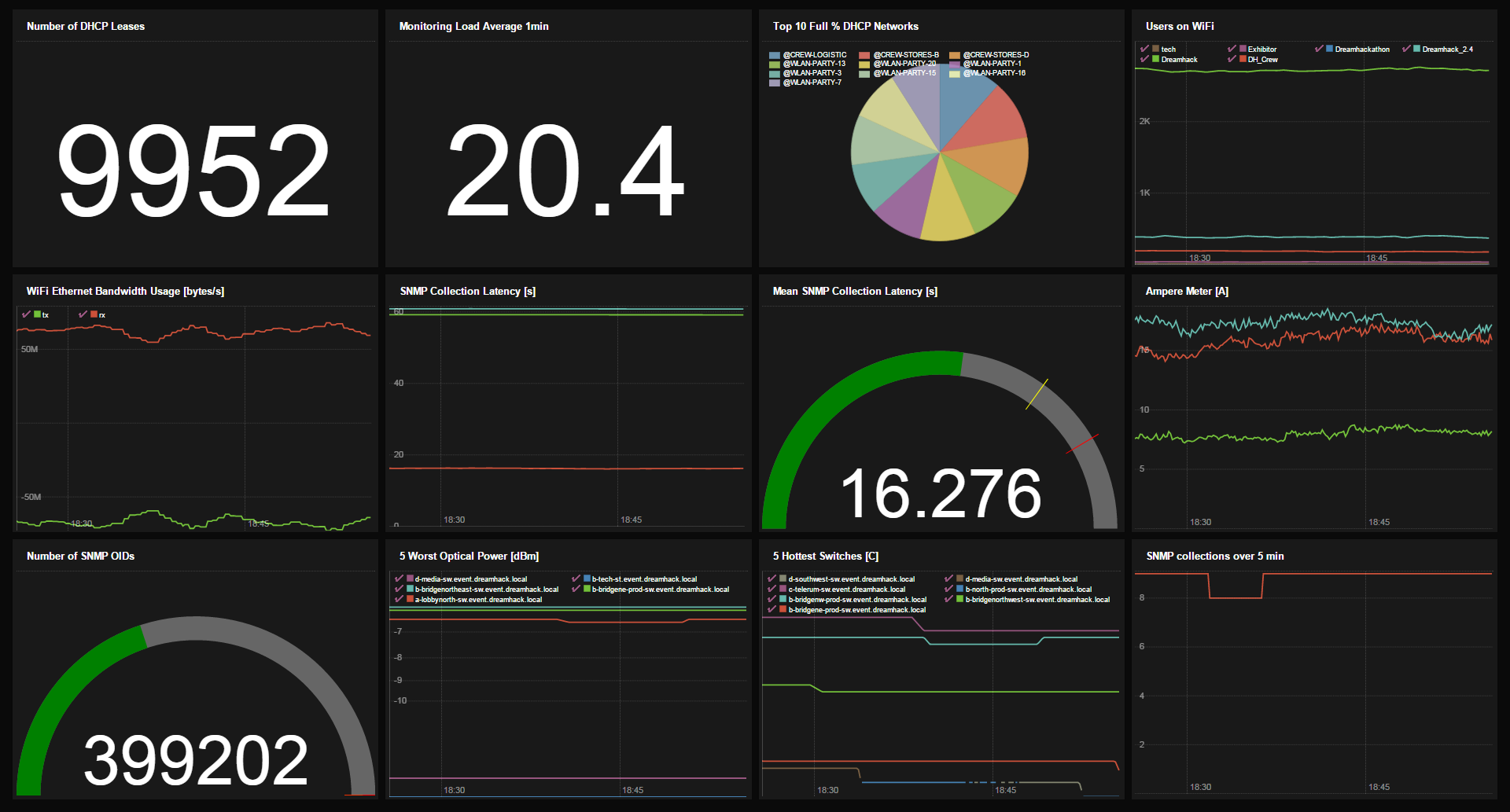
Monitoring
Logging
- kubectl logs
- Node level
- Cluster Level
- Side Car
Logging
- kubectl logs
apiVersion: v1
kind: Pod
metadata:
name: counter
spec:
containers:
- name: count
image: busybox
args: [/bin/sh, -c,
'i=0; while true; do echo "$i: $(date)"; i=$((i+1)); sleep 1; done']
$ kubectl logs counter
0: Mon Jan 1 00:00:00 UTC 2001
1: Mon Jan 1 00:00:01 UTC 2001
2: Mon Jan 1 00:00:02 UTC 2001
Node Level
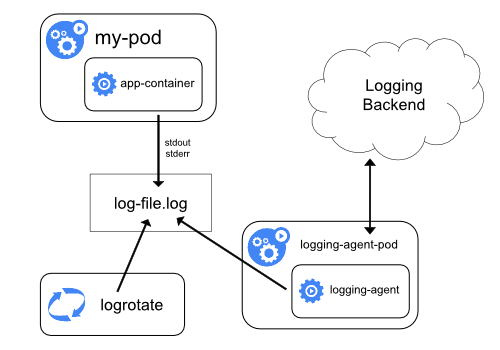
Side Car
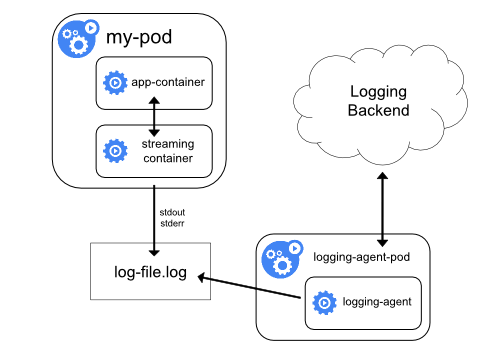
Container security primitives
- SElinux
- AppArmor
- Seccomp
Container Pipeline
- Establish a pipeline to build a standard image
- Have a versioning policy
- Allow to only run images based of the standard image
- Use the same OS as the host
- Keep the image small
- Use a private registry
- Don’t embed secrets into images, use Hashicorp Vault
- https://www.cisecurity.org/benchmark/docker/
- https://github.com/docker/docker-bench-security
K8 Security
- RBAC
- NetworkPolicy
- TLS
- Image Scanning
- Aquasec/Twistlock
- Integrating with HashiCorp Vault other public cloud secret stores
- Investigate using a container based OS (CoreOS, Atomic Linux)
- Harden and tweak
- Make sure to pass https://github.com/dev-sec/linux-baseline
Security Vendors
- Aquasec https://www.aquasec.com/
- Twistlock https://www.twistlock.com/
- Sysdig Falco https://www.sysdig.org/falco/
Closing remarks

Contact Me:
Email: james.strong@contino.io

